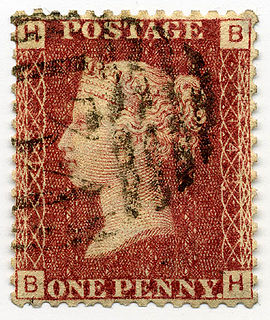
Postage stamps and postal history of Great Britain surveys postal history from the United Kingdom and the postage stamps issued by that country and its various historical territories until the present day.
William Arthur Smith was an American artist.
George Townsend Turner of Washington, D.C., was considered a leading philatelic bibliophile of his era, amassing a very large body of philatelic literature over his lifetime. He was the acting curator of the Smithsonian Institution's philatelic collection from 1959 until 1962 and was the owner of the largest private philatelic library ever assembled.
William Reynolds Ricketts, of Forty Fort, Pennsylvania, was a philatelist who created the largest index of philatelic literature available during his lifetime. He was considered as the "greatest philatelic indexer of all time." Ricketts was the son of R. Bruce Ricketts and Elizabeth Reynolds Ricketts, for whom Ricketts Glen State Park in Pennsylvania is named.
William Carlos Stone, called "Uncle Billy" by his friends, of Springfield, Massachusetts, was a philatelist who specialized in the collection of philatelic literature related to revenue stamps and postal stationery.

The Roll of Distinguished Philatelists (RDP) is a philatelic award of international scale, created by the Philatelic Congress of Great Britain in 1921. The Roll consists of three pieces of parchment to which the signatories add their names.
Henry Albert Meyer of Indiana, was a philatelist who created notable stamp and postal history collections, and wrote and co-authored a number of philatelic books.
Woodrow Wilson Hulme II was a philatelist noted for his work in advancing the appreciation of stamp collecting, especially by his work at the National Postal Museum in Washington, D.C.
Franklin Richard Bruns Jr. (1912–1979) of Maryland, was a student of philately and served it in numerous ways, including writing a syndicated stamp collector newspaper column and serving as curator at the Smithsonian Institution.
Vincent Domanski Jr., of Philadelphia, Pennsylvania, was active in local Philadelphia philately, and also on a national level. He was of Polish descent.
Joseph Britton Leavy, of New York City and Washington, D.C., was an active stamp collector who served at the Smithsonian Institution in Washington, D.C.
Dr. Gordon H. Torrey, of Maryland, was a stamp collector active within the Washington, D.C., area, and at the national level.
Patricia A. (Trish) Kaufmann of Lincoln, Delaware, is an expert on the postage stamps and postal history of the Confederate States of America (CSA), and has written hundreds of articles on the subject; she is known as a diligent researcher who brings postal history to life. She is also a speaker on the subject.
Barbara Ruth Mueller was an American philatelist who remained, all her life, dedicated to the study of American philately. Her studies led her to a career of writing significant philatelic literature.
Nancy B. Clark of Marstons Mills, Massachusetts, is a philatelist who has served the philatelic community by her pioneering work with the Boy Scouts of America and her dedication to work at the American Philatelic Society.
Peter P. McCann, of University Park, Florida, is a philatelist who has supported the hobby of philately on a national scale. For his varied services to the American Philatelic Society (APS) over several decades, he was awarded in 2008 the Luff Award for outstanding service to the society.
Svend Yort (1908–1981) was a noted collector of the postage stamps and postal history of Scandinavia, and was a writer and expert on the subject.
Leo August, of New Jersey, was a philatelist who, as a stamp dealer and publisher, created interest and awareness in the collecting of first day covers through the introduction in 1939 of "ArtCraft" engraved illustrated envelopes for use as first day covers. He also established the landmark line of "White Ace" stamp albums. ArtCraft became one of the world's most popular cachets.
Cheryl R. Ganz, FRPSL is an American philatelist who was appointed to the Roll of Distinguished Philatelists in 2018.






